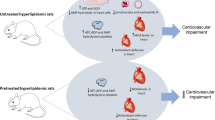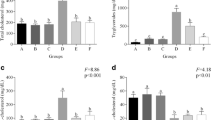Abstract
Purinergic system has been proven to play a critical role in the inflammatory process and to represent an important therapeutic target to improve the immune response during hypercholesterolemia. β-caryophyllene, a phytocannabinoid compound, has a powerful hypolipidemic and anti-inflammatory actions. However, the effects of β-caryophyllene on seric enzymes of purinergic system have not been evaluated. The purpose of this study was to investigate whether β-caryophyllene is able to ameliorate the seric activities of NTPDase and adenosine deaminase (ADA) in a model of hypercholesterolemia induced by Triton WR-1339. The activities of NTPDase and ADA were evaluated enzymatically, and the seric levels of β-caryophyllene were evaluated by high-performance liquid chromatography. We found that treatment with β-caryophyllene ameliorates the enzymatic activities of NTPDase and ADA in serum of hypercholesterolemic rats, in a concentration-dependent manner. These results indicated that β-caryophyllene treatment could improve the immune response during hypercholesterolemia through purinergic pathway.




Similar content being viewed by others
References
Otunola GA, Oloyede OB, Oladiji AT, Afolayan AA (2010) Effects of diet-induced hypercholesterolemia on the lipid profile and some enzyme activities in female Wistar rats. Afr J Biochem Res 4:149–154
Tailor A, Granger DN (2003) Hypercholesterolemia promotes P-selectin-dependent platelet-endothelial cell adhesion in postcapillary venules. Arterioscler Thromb Vasc Biol 23:675–680
Meng Q, Shi D, Feng J, Su Y, Long Y, He S, Wang S, Wang Y, Zhang X, Chen X (2016) Hypercholesterolemia up-regulates the expression of intermedin and its receptor components in the aorta of rats via inducing the oxidative stress. Ann Clin Lab Sci 46:5–17
Santos-Gallego CG, Picatoste B, Badimón JJ (2014) Pathophysiology of acute coronary syndrome. Curr Atheroscler Rep 16:1–9
Shi Y, Cosentino F, Camici GG, Akhmedov A, Vanhoutte PM, Tanner FC, Luscher TF (2011) Oxidized low-density lipoprotein activates p66Sch via lectin-like oxidized low-density lipoprotein receptor-1, protein kinase C-β, and c-Jun N-terminal kinase in human endothelial cells. Arterioscler Thromb Vasc Biol 31:2090–2097
Allahverdian S, Chehroudi AC, McManus BM, Abraham T, Francis GA (2014) Contribution of intimal smooth muscle cells to cholesterol accumulation and macrophage-like cells in human atherosclerosis. Circulation 129:1551–1559
Ferrari D, Vitiello L, Idzko M, la Sala A (2015) Purinergic signaling in atherosclerosis. Trends Mol Med 21:184–192
Zimmermann H (2001) Ectonucleotidases: some recent developments and note on nomenclature. Drug Dev Res 52:44–56
Kawashina Y, Nagasawa T, Ninomiya H (2000) Contribution of ecto-5′nucleotidase to the inhibition of platelet aggregation by human endothelial cells. Blood 96:2157–2162
Bours M, Swennen E, Di Virgilio F, Cronstein BN, Dagnelie PC (2006) Adenosine 5′triphosphate and adenosine as endogenous signaling molecules in immunity and inflammation. Pharmacol Ther 112:358–404
Marcus AJ, Broekman MJ, Drosopoulos JHF, Pinsky DJ, Islam N, Gayle RB, Maliszewski CR (2011) Thromboregulation by endothelial cells: significance for occlusive vascular diseases. Arterioscler Thromb Vasc Biol 21:178–182
Hechler B, Gachet C (2011) P2 receptors and platelet function. Purinergic Signal 7:293–303
Duarte MM, Loro VL, Rocha JBT, Leal DBR, de Bem AF, Dorneles A, Morsch VM, Schetinger MRC (2007) Enzymes that hydrolyze adenine nucleotides of patients with hypercholesterolemia and inflammatory processes. FEBS J 274:2707–2714
Ruchel JB, Rezer JFP, Thorstenberg ML, dos Santos CB, Cabral FL, Lopes STA, da Silva CB, Machado AK, da Cruz IBM, Schetinger MRC, Gonçalves JF, Leal DBR (2016) Hypercholesterolemia and Ecto-enzymes of purinergic system: effects of Paullinia cupana. Phytother Res 30:49–57
Chtourou Y, Kamoun Z, Zarrouk W, Kebieche M, Kallel C, Gdoura R, Fetoui H (2016) Naringenin ameliorates renal and platelet purinergic signalling alterations in high-cholesterol fed rats through the suppression of ROS and NF-κB-signaling pathways. Food Funct 7:183–193
Pilla C, Emanuelli T, Frassetto SS, Battastini AMO, Dias RD, Sarkis JJF (1996) ATP diphosphohydrolase activity (apyrase, EC 3.6.1.5) in human blood platelets. Platelets 7:225–230
Calleja MA, Vieites JM, Meterdez TM, Torres MI, Faus MJ, Gil A, Suarez A (2013) The antioxidant effect of β-caryophyllene protects rat liver from carbon tetrachloride-induced fibrosis by inhibiting hepatic stellate cell activation. Br J Nutr 109:583–586
Bento AF, Marcon R, Dutra RC, Claudino RF, Cola M, Leite DFP, Calixto JB (2011) β-caryophyllene inhibits dextran sulfate sodium-induced colitis in mice through CB2 receptor activation and PPARγ pathway. Am J Pathol 178:1153–1166
Basha RH, Sankaranarayanan C (2016) β-Caryophyllene, a natural sesquiterpene lactone attenuates hyperglycemia mediated oxidative and inflammatory stress in experimental diabetic rats. Chem Biol Interact 245:50–58
Baldissera MD, Souza CF, Grando TH, Doleski PH, Boligon AA, Stefani LM, Monteiro SG (2017) Hypolipidemic effect of β-caryophyllene to treat hyperlipidemic rats. Naunyn-Schmiedeberg’s Arch Pharmacol 390:215–223
Lin W, Kuo Y, Chang Y, Teng C, Wang E, Ishikawa T, Chen I (2003) Anti-platelet aggregation and chemical constituents from the rhizome of Gynura japonica. Planta Med 69:757–764
Oses JP, Cardoso CM, Germano RA, Kirst IB, Rucker B, Furstenau CR, Wink MR, Bonan CD, Battastini AM, Sarkis JJ (2004) Soluble NTPDase: an additional system of nucleotide hydrolysis in rat blood serum. Life Sci 74:3275–3284
Chan KM, Delfert D, Junger KD (1986) A direct colorimetric assay for Ca2+-stimulated ATPase activity. Anal Biochem 157:375–380
Giusti G, Gakis C (1971) Temperature conversion factors, activation energy, relative substrate specificity and optimum pH of adenosine deaminase from human serum and tissues. Enzyme 12:417–425
Bradford MM (1976) A rapid and sensitive method for the quantification of microgram quantities of protein utilizing the principle of protein-dye binding. Anal Biochem 72:248–254
Porel A, Sanyal Y, Kundu A (2014) Simultaneous HPLC determination of 22 components of essential oils; method robustness with experimental design. Indian J Pharm Sci 76:19–30
Yegutkin GG (2015) Enzymes involved in metabolism of extracellular nucleotides and nucleosides: functional implications and measurements of activities. Crit Rev Biochem Mol Biol 49:473–497
Abbracchio MP, Ceruti S (2007) P1 receptors and cytokine secretion. Purinergic Signal 3:13–25
Baldissarelli J, Santi A, Schmatz R, Abdalla FH, Cardoso AM, Martins CC, Dias GRM, Calgaroto NS, Pelinson LP, Reichert KP, Loro VL, Morsch VM, Schetinger MRC (2016) Hypothyroidism enhanced ectonucleotidases and acetylcholinesterase activities in rat synaptosomes can be prevented by naturally occurring polyphenol quercetin. Cell Mol Neurobiol 37:53–63
Ojha S, Javed H, Azimullah S, Haque ME (2016) β-caryophyllene, a phytocannabinoid attenuates oxidative stress, neuroinflammation, glial activation, and salvages dopaminergic neurons in a rat model of Parkinson disease. Mol Cell Biochem 418:59–70
Andrade-Silva M, Correa LB, Candéa ALP, Cavalher-Machado SC, Barbosa HS, Rosas EC, Henriques MG (2016) The cannabinoid 2 receptor agonist β-caryophyllene modulates the inflammatory reaction induced by Mycobacterium bovis BCG by inhibiting neutrophil migration. Inflamm Res 65:869–879
Author information
Authors and Affiliations
Corresponding authors
Rights and permissions
About this article
Cite this article
Baldissera, M.D., Souza, C.F., Doleski, P.H. et al. Enzymes that hydrolyze adenine nucleotides in a model of hypercholesterolemia induced by Triton WR-1339: protective effects of β-caryophyllene. Mol Cell Biochem 434, 127–134 (2017). https://doi.org/10.1007/s11010-017-3042-9
Received:
Accepted:
Published:
Issue Date:
DOI: https://doi.org/10.1007/s11010-017-3042-9




